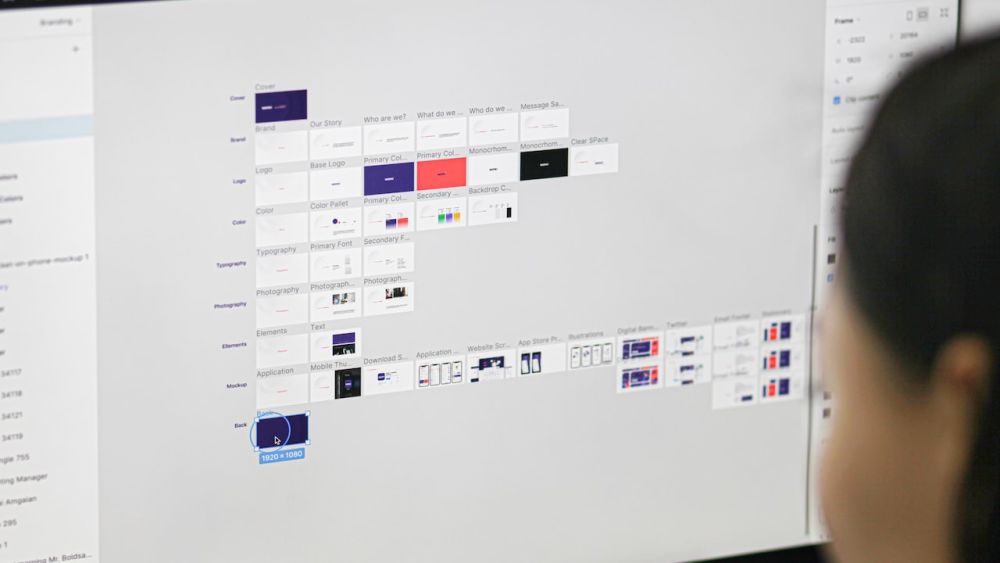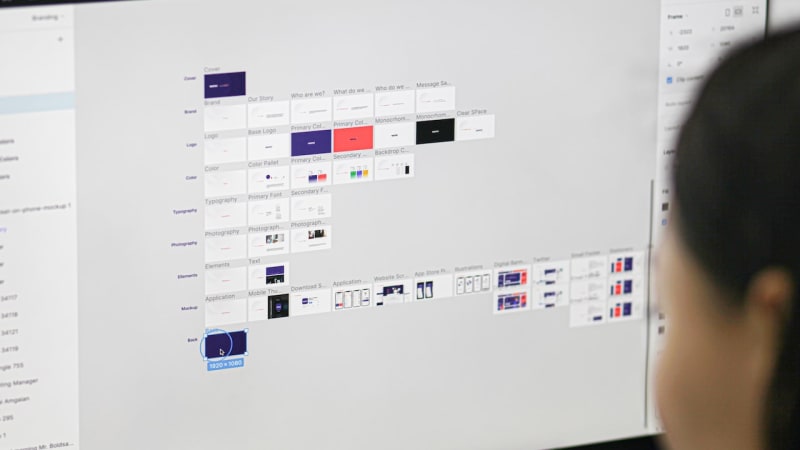
Adobe's $20 Billion Purchase of Figma: Thoughts from a UX Designer
Adobe's recent purchase of Figma for $20 billion has been making headlines and causing quite a stir in the design industry. This move, which values Figma at 50 times its reported $400 million in annual revenue, has raised a lot of questions and sparked much discussion. Here, we share the thoughts of a UX designer who works at Adobe but has no insider knowledge of the deal.
The Difference Between Figma and Adobe's Products
Adobe has been building native software for many years, running across platforms and dominating the design software market since the 1990s. Raster graphics with Photoshop, photo editing with Lightroom, and UX design with Illustrator and Photoshop are just a few of the tools that Adobe offers. However, these tools were never ideal for UX designers. Fireworks was a more suitable tool, but after Adobe acquired Macromedia, it was discontinued, and most UX designers went back to Photoshop or Illustrator.
The Need for Faster and More Collaborative Tools
The desire for faster, more nimble, and lower-fidelity tools than Photoshop and Illustrator has always been there. Sketch was the first tool to meet this demand, followed by Figma, which has become the cross-platform and more collaborative version of Sketch. Figma has dominated this market segment and has yet to be dethroned by Adobe.
Why Adobe Overpaid for Figma
If we look at the numbers, it is difficult to understand why Adobe would pay $20 billion for Figma. Analysts agree that Adobe overpaid by at least 100%. However, there are a few possible explanations for this. If Adobe had waited a few years, Figma could have been acquired by Microsoft or Google and become just another generic tool. By overpaying for Figma now, Adobe has ensured that it will remain the dominant player in the design software market.
The Negative Image of Adobe
Adobe has developed a negative image due to its predatory subscription model, which charges an early termination fee on a two-year contract for a piece of software. This is not a popular opinion, but it is the truth. Designers rarely complain about the software itself, but the pricing model is a major issue.
A New Path for Adobe
Adobe's acquisition of Figma could be a turning point for the company. On the surface, it may seem like Adobe has simply acquired Figma and regained its dominance in the design software market. However, there is a more interesting path that Adobe could take. The recent release of Photoshop Web and Adobe Express, combined with the acquisition of Figma's cross-platform and collaborative team, could result in a totally new and reinvigorated Adobe. The new company could be a web-based, collaborative version of Adobe's current software, and could completely change the way that designers work.
In conclusion, Adobe's acquisition of Figma has the potential to be much more than just a market acquisition. If done right, it could result in a completely new and reinvigorated Adobe, which could completely change the way that designers work. Only time will tell, but this move has certainly created a lot of excitement and possibility in the design industry.
-----

Adobe's $20 Billion Acquisition of Figma: What it Means for the Future of Design
Adobe's recent acquisition of Figma for a whopping $20 billion, half cash and half stock, has sent shockwaves throughout the design community. Adobe, the industry giant that has dominated the native software market since the 1990s, has made a bold move to purchase the popular cross-platform, web-based design tool Figma. In this article, I will share my thoughts on this acquisition as a UX designer and Adobe employee who had no prior knowledge of the deal.
A Look at Figma vs Adobe Products
For decades, UX design was done in Illustrator and Photoshop, but these tools were never ideal for UX designers. Fireworks was a popular tool among UX designers, but after Adobe acquired Macromedia and killed off Fireworks, most UX designers went back to using Photoshop or Illustrator. However, there was always a desire for a faster, more nimble, and lower-fidelity tool for UX design, and Sketch and Figma filled that gap, with Figma becoming the cross-platform, more collaborative version of that tool.
Why Adobe Overpaid for Figma
While many Wall Street analysts argue that Adobe overpaid for Figma by at least 100%, there is a deeper strategy at play. If Adobe had waited a couple of years and let Figma become a generic startup acquisition, then Microsoft or Google could have bought Figma, making it a generic tool. But by overpaying for Figma, Adobe has the opportunity to reinvent itself and rebrand away from its negative image, developed through its predatory subscription model.
The Exciting Path for Adobe
The most exciting path for Adobe is the release of Photoshop Web and Adobe Express, which signals a trend towards web-based, collaborative versions of Adobe's software. By hiring the team that built the most successful cross-platform, web-based design tool in the industry and integrating some of those people into the teams working on web versions of Photoshop, Illustrator, and Adobe Express, Adobe could rebirth itself as a totally new company.
Final Thoughts
While it's unclear what the future holds for Adobe and Figma, there is a lot of potential for Adobe to rejuvenate itself and become a new company if it does it right. Whether or not the management teams intend to do this remains to be seen, but if Adobe can get the culture right, it could be a game-changer for the industry.
----------
The Tweet
"Adobe's $20 billion acquisition of Figma has the potential to reinvigorate the company. Could this move bring a shift from multi-platform desktop software to web-based collaborative versions? #Adobe #Figma #UXdesign #webdesign"
Workflow:
- Transcribed using Whisper.cpp (higher-quality model)
- Rewritten using Chat GPT
- Run RoBERTa Base OpenAI Detector
- Tweet from Chat GPT
Rewrite the following transcript as a blog post in the style of Medium.com, with headlines, paragraphs, and lists:Turn it into a TweetRoBERTa:

Original Transcription:
So the latest headline, Adobe purchasing Figma for $20 billion, half cash, half stock, double their valuation. 50 times they're reported 400 million in annual revenue. Expensive, even few value their employees at millions and millions of dollars. I'm going to share my thoughts. This is as somebody who works at Adobe who has no insight into the deal, no insight as to why Adobe would make purchase Figma. No idea this was happening before the news was announced. But at the same time, a UX designer who would never use Adobe XD on a daily basis. Here's kind of my thoughts. If you think about Figma versus Adobe's products, Adobe builds a lot of native software, runs across platforms, but they're maintaining this suite of native software which is dominated pretty much every vertical since the 1990s. Talk about raster graphics with Photoshop, photo editing in Lightroom. For a long time, UX design happened in Illustrator and Photoshop before that. These were never good tools for UX designers. Fireworks came along and UX designers loved that. After Adobe acquired Macromedia, they killed that off. Most UX designers went back to Photoshop or Illustrator. When I say UX designers, nobody was calling themselves a UX designer back then. They were always calling themselves. There was a lot of blurring the lines between what we would call a UI designer and a UX designer today. Or a product designer. It was kind of a more holistic thing. We had a lot of skeuomorphic design happening up until the mid-2000s, late 2010s really. Having a tool like Photoshop or Illustrator with the power to create highly detailed interface designs also be the tool that you use to create UX designs, maybe supplemented with a wireframing tool like Axer, Balsamic. This wasn't a horrible idea but there was always a desire for something faster, nimbler and lower fidelity than Photoshop in Illustrator. And Sketch was a revival of that tool followed by Figma which became the cross-platform more collaborative version of that. And Adobe's never clogged that segment of the market back. Or as Figma basically dominates it right now. So if you look at any Wall Street analysts, I've read half a dozen takes and they're all exactly the same. If you look at the numbers, there is no way $20 billion makes sense. Adobe overpaid by at least 100%. But think about why they've overpaid. Because if you wait a couple years and let this become a generic late startup life cycle market acquisition, somebody like Microsoft or Google buys Figma, right? And this becomes a generic tool. They make a nice home for the team to continue working on their tool and make surface level integrations into other Microsoft products. And they guarantee that there's a Windows based design tool that competes against Max dominance in the design industry. There's a path for that, it's just not very exciting. There's a more exciting path for Adobe to reinvent itself and to rebrand itself away from kind of the negative image it's developed through its predatory subscription model. None's not an opinion. Like that's not... I'm sure, you know, it's not a popular thing to say as an employee, but charging. An early termination fee on a two year contract for a piece of software is just predatory. There's no other word for it. And if you talk to designers, you never hear them complaining about any aspect of Photoshop or Lightroom or Illustrator that they don't like in the software, right? They very rarely complain. There's a lot to complain about, but that's not the complaint you hear that makes them not want to use Adobe products. It's the pricing model. But anyway, back to the more interesting path that Adobe could take. Surface level, people might see this as an acquisition where Adobe just acquires Figma and now they dominate every vertical of design software across all platforms and they've, you know, restored themselves to where the company was in the mid-2000s. And that alone makes it worth $20 billion. Especially considering what is Adobe going to spend the additional money on anyway? Stock buybacks, developing new products, like they're not cash strapped. They're more in a situation like Apple is today where they don't know what to spend the money on. No, more interesting is one thing that's been underreported, I think, is the release of Photoshop Web and Adobe Express. This is a trend that I'm kind of seeing from inside the company, but it's unofficial. I mean, you see the trend from outside the company too. There's no secret around this. But if you think about a company that wants to shift from multi-platform desktop software gradually into web-based collaborative versions of that software, think about the impact of hiring the team that built the most successful cross-platform web-based design tool in the industry. And then filtering some of those people into the teams working on a web version of Photoshop, an Illustrator, an Adobe Express, and filtering them throughout the company and letting that culture intermingle with Adobe's culture and reinvigorate the company. I'm not saying this is what's going to happen. I don't even know if management teams intend to do this, but you could really rebirth Adobe as a totally new company out of the Figma acquisition if you did it right. But then again, it'd be a little bit like an inverse of the Lockheed Martin acquisition by a Boeing, where people joked Lockheed Martin bought Boeing with Boeing's money. If you let Figma buy Adobe with Adobe's money, the resulting company, if you get the culture right, more than 20 billion of value to Adobe.